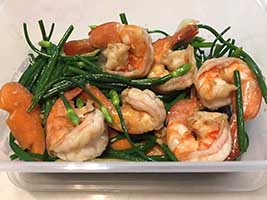 There are varieties of cuisines found in Malaysia, the local and the foreign one, which practically serves the taste bugs for all. There are varieties of cuisines found in Malaysia, the local and the foreign one, which practically serves the taste bugs for all. Malaysia has been gifted with reliable weather and lush landscape, and its multi-racial population with different cooking and eating styles provide the country with variety dishes and flavours to thrill the taste bugs for all. You can encounter an adventurous spectrum of dining experiences available in Malaysia. Eating places are found in morning markets, night markets, dusty roadside stalls, opened-air hawker centres, food courts, restaurants and noisy Chinese coffee shops, to cooling air-conditioned restaurants and Western fast food outlets. The choices are plentiful, thrilling and adventurous. 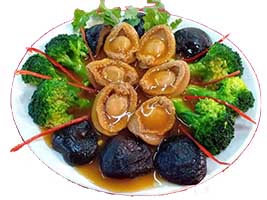 The normal meals of the local Malaysians consist of rice, meats, seafood, and vegetables. In general, Malay cuisines or food are heavily seasoned and spicy. Chillies are the Malays' everyday never-missed-me type of ingredient. They are either in dishes or blended sambal sauce (chilli sauce). The rempah (a pounded paste of chillies, garlic, galangal, lemongrass, onions and fresh turmeric) is stir-fried in hot oil to release its tantalizing aromas before adding the main ingredient such as beef, chicken, seafood, etc to the cooked rempah. The normal meals of the local Malaysians consist of rice, meats, seafood, and vegetables. In general, Malay cuisines or food are heavily seasoned and spicy. Chillies are the Malays' everyday never-missed-me type of ingredient. They are either in dishes or blended sambal sauce (chilli sauce). The rempah (a pounded paste of chillies, garlic, galangal, lemongrass, onions and fresh turmeric) is stir-fried in hot oil to release its tantalizing aromas before adding the main ingredient such as beef, chicken, seafood, etc to the cooked rempah.Chinese food in Malaysia is considerably more traditional and less novel. Its cooking is much less in seasoned and spicy as compared to the Malay's food. Its different varieties and delicious cuisines tempted you to try for more. Dainty dim sum (dumplings), spicy Sichuan food, Cantonese food, Hokkien food, Chinese food with local cooking style and others are available in Malaysia and cooked to high standards with delicious taste. The Indian cuisines are strongly seasoned with dried spices. Some Indian restaurants served the food with banana leaf on the dish. The banana leaf itself is not eaten but act as disposable green plate. Discover the challenge and adventure in cuisine or food in Malaysia. It's a great experience for those visitors with culture, cooking and eating styles that different from the Malaysians. |
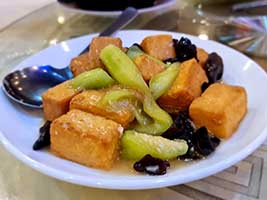 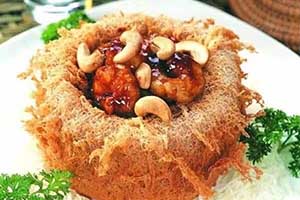 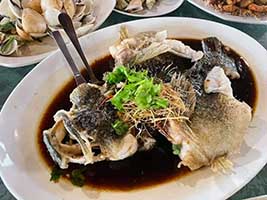 |
| Chinese Cuisine / Food |
|
Malaysia truly became a melting point of cultures with the arrival of immigrants from all over China, including the Hokkiens, Hakkas, Teochews, Foo Chows, Cantonese, and Hainanese in the 19th century, whose cuisines blended well with the already existing potpourri. Chinese cuisine is known for its diversity. Chinese cuisine in Malaysia is mainly Cantonese, Hokkien, Hainanese, Teochew and Hakka styles of cooking. Chinese cuisine is generally milder compared to Malay or Indian fare. But thanks to the influence from this multi-ethnic country, Chinese cuisine in Malaysia, has taken on a spicier touch, often reinventing classic Chinese dishes. Many Chinese dishes are unique in Malaysia and not found in China. The most popular Chinese cuisine in Malaysia is Cantonese style. A Chinese culinary experience can be anything from a road stall for a simple bowl of noodles to a ten-course banquet at a sophisticated restaurant. The noodles come in various shapes and colours - flat, cylinderical, thin, thick, white and yellow. These can be done in many ways to make them a delicious bowl or plate of noodles to serve in front of you. Chinese cuisines are a culinary adventure with mouth-watering dishes. The simple stir fried food, the beggar chicken, the steamed fish, the butter prawn, the roasted duck, the suckling pig, the herbal chicken, the fried rice wrapped with lotus leave, the pancake, and many more exotic food. You may look out for more info at our "Discover Malaysia" section or search for Chinese cuisine or Chinese food. |
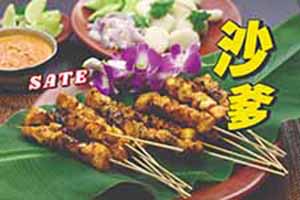 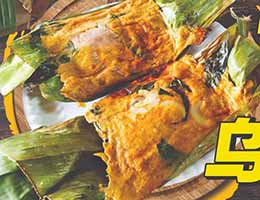 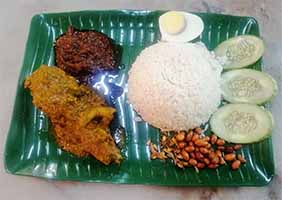 |
| Malay Cuisines / Food |
|
Natural, homegrown ingredients figure prominently in Malay food. When you are in Malaysia, having some time to enjoy the wonderful varieties of Malay food is a must. Coconut, pandan (screwpine) leaves, chili, lemon grass, lime leaves, spices and turmeric are basic ingredients cooked with fish, meat or vegetables. Besides that, fresh herbs such as daun kemangi (a type of basil leaves), daun kesum, nutmeg, kunyit and bunga kantan are also often used. Influenced by the neighboring countries such as Indonesia, India, the Middle East and China, the traditional culinary style is often described as spicy and flavorful as the technique utilizes a melting pot of spices and herbs. A traditional accompaniment to meals is a hot sambal made of ground chili, prawn paste and condiments. Malay cuisine has a range of flavors such as spicy, sharp, sweet and sour with each of the Malaysian state having a distinct taste and flavors. Kelantanese cuisine, for example has a sweetish taste due to liberal use of coconut milk and sugar in cooking. Kedah's cuisines spicier due to influence of Indians who arrived here during the spice trade centuries ago. But unlike Indian cuisine which uses only hard spices (cloves, cinnamon, caraway, etc). Malay cuisine uses hard spices together with wet spice mixture called rempah. For your info, the best time to sample authentic Malay food is during the uniquely Malaysian custom of holding an "open house" during Hari Raya Puasa (Hari Raya Aidilfitri), which marks the end of the whole month Ramadan fasting. You can also taste the Malay cuisine in Malay restaurants, stalls and food courts found in all parts of Malaysia. You may look out for more info at our "Discover Malaysia" section or search for Malay cuisine or Malay food. |
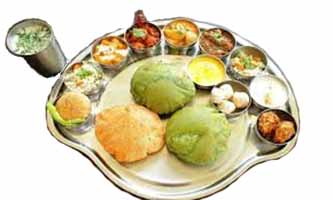 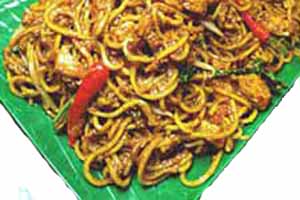 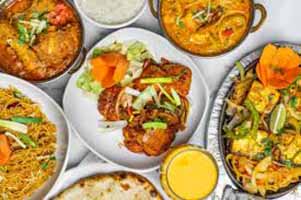 |
| Indian Cuisines / Food |
|
During the booming period of rubber of Colonial Malaya, various ethnic groups arrived such as Tamils, Bengalis, Malayalees, Sri Lankas and Punjabis, who each added their own cooking styles to the cuisines. Indian Cuisine make used of individual spice blend to enhance the flavor of each dishes. There are more thank a thousand spice blends or masala, each with its particular aroma, character and a blend of flavors such as spiciness, sourness, bitterness and a bit of hotness. For example, fish is cooked in a spice of blend of 'cool' spices like fenugreek and cumin to remove the fishy smell while chicken and meat dishes require 'warm' spices like cinnamon, cloves, star anise and caraway seeds. Yogurt almost always ends a meal to cool down the hotness of the dishes. Manu Indians are vegetarians and Indian vegetarian dishes particularly South Indian banana leaf style rice is the most famous in Malaysia. There are three main categories of Indian cuisines in Malaysia - North Indian, South Indian and Indian Muslim (known as mamak in Malaysia). North Indian cuisine has rich creamy sauces. South Indian food is both hot and spicy. The Indian Muslim cuisine is a mix of Indian and Malay cooking styles. Indian food can easily be found in hawker stalls and restaurants in the country. You may look out for more info at our "Discover Malaysia" section or search for Indian cuisine or Indian food. |
| Baba And Nyonya Cuisines / Food |
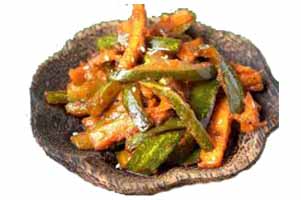 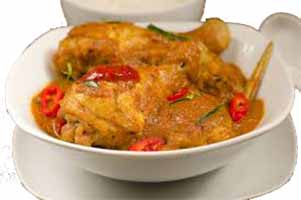 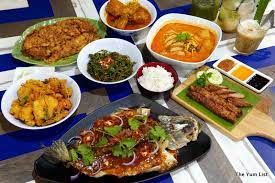 |
|
Baba and Nyonya Cuisine or Nyonya food in short, is also known as the Straits Chinese food which is an interesting amalgamation of Chinese and Malay dishes thought to have originated from the Peranakan (Straits Chinese) of Melaka (Malacca). Besides Malacca, Nyonya food is also native to Penang and Singapore. However, over the years, distinct differences have evolved in the Nyonya recipes found in Penang than that in Malacca and Singapore due to the proximity of Malacca and Singapore to Indonesia and Penang to Thailand. Influences aside, Nyonya recipes are complicated affairs, often requiring many hours of preparation and is about the blending of spices, using pungent roots like galangal, turmeric and ginger; aromatic leaves like pandan leaf and fragrant lime leaf together with other ingredients like candle nuts, shallots, shrimps paste and chilies. Lemon, tamarind, carambola and green mangoes are used to add a tangy taste to many dishes. For dessert, fruits are seldom served but instead colorful cakes are served. Nyonya cakes are rich and varied, often made from ingredients like sweet potato, glutinous rice, palm sugar and coconut milk. You may look out for more info at our "Discover Malaysia" section. |
| Other Cuisines / Food |
|
There are many other cuisines found n Malaysia which may not be originated from Malaysia. If you want to taste other cuisines in other parts of the world, you may find it a good place in Malaysia. American food, French cuisines, Indonesian cuisines, Italian food, Japanese food, Hong Kong cuisines, Korean cuisines, Thais cuisines, Taiwanese food, Vietnamese food, Western food, etc. The taste may be better and more delicious than that from the original countries. Try it out yourself. |
